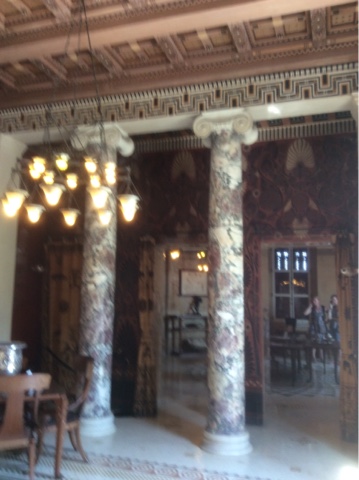MOUGINS
On this new day, I visited a couple of places that I wasn't especially keen on, but I still kept an open mind. This ended up to my benefit because I really enjoyed all of them.
The first town to visit today was Mougins. It is a quiet town at the top of a hill. In addition to the few things to see, I really enjoyed the calm atmosphere of a place that seemed a bit off the beaten path. However, one great site to explore was the Museum of Classical Art. To be sure, they had a small but fine collection of ancient Greek and Roman and Egyptian art, from pottery to sculpture, along with arms and armor. However, one thing that I liked about this museum was that it had a very interesting curatorial touch. Along side this ancient works, they placed works by modern and early modern artists, such as Picasso, Warhol, and Damien Hirst, among others.
Some people might call such a presentation eclectic; after all, how can such modern works be placed next to ancient ones? However, I approached this presentation from a completely different angle. Rather than see the difference in times and places where these works were produced, I chose to focus on the similarity in themes. That is, despite the fact that thousands of years separate these works of art, it seems to speak to something of the community in which artists place themselves. I am sure that Picasso and Hirst learned their art by studying older works of art, going all the way back to the ancient period (Well, maybe not Hirst; I think I read that he went to an art school where they didn't really care to teach him in the traditional manner, such that he didn't even have to learn how to draw; but still, I don't think that hurts my point too much). I imagine the artists working today, even, believing that they are part of a tradition that spans across all humanity, no matter the time or place.
ROTHSCHILD VILLA
There was once a woman, Beatrice Ephrussi who married into the famously rich Rothschild family, and thus became rich herself. What she did with this wealth is build a home in Saint-Jean-Cap-Ferrat filled with intricate ornamentation, and expansive gardens that tried to echo many different cultures. It so happens that when this rich woman died, the home was opened as a museum of sorts that tourists can come, visit, and walk through. It certainly didn't sound like my cup of tea, but the serene walk through the gardens was very pleasant and I did enjoy it.
GREEK VILLA
In conjunction with the Rothschild house, there is another villa in Beaulieu-Sur-Mer called Villa Kerylos. This villa was bought and designed by yet another rich person, Theodore Reinach during the Belle Epoque. In contrast to the Rothschild villa, that went for a more regal and French design motif, Reinach here decided to go with Greek motifs.
Outside the house, there was a bronze bust of the hero of Greek independence, Eleftherios Venizelos. This, paired with the plaque on Nikos Kazantakis' home in Antibes the previous day, reminded me that France was one of the great powers that played a significant role in assisting Greece in its war for independence from the Ottoman Empire.
The interior of the home was adorned with Greek replica sculptures, columns, and mosaic floors.
However, it was clearly a modern place where a wealthy phil-Hellene lived.
However, it was on the basement level where I was most impressed. There is a narrow corridor that seems to follow the outline of the property, but being this lower level, the windows gave a view right on the sea level. This basement, although with larger than life sculptures of classical figures, was not especially adorned with other ornamentation like the upper level was.
Instead the old stone brick wall was exposed, and I could actually imagine it being a dungeon or prison if left barren. However, along with the classical sculptures, there was also a photography exhibition lining the walls from the late 19th century. I really enjoyed seeing these photos of old Greece, only a few decades after independence, with commoners living their olden ways of life. It certainly gave a view of Greece with windmills and open fields that is far different from the Athenian sprawl of today.
All of this love for the Greek culture reminded me of very complicated ideas regarding the current Greek nation, and its relation with the ancient culture. I don't think that it is any secret that today Greece is not doing very well, and has recently been bailed out for the third time to avoid sovereign bankruptcy. For many years I have held the controversial belief that Greece relies too much on its historical legacy, to the detriment to progressing with modernity. Venizelos and Kazantzakis, I think, were both aware of this Greek conflict between tradition and modernity, and I don't believe it has yet been resolved. I disagree with the plaque at the entrance of the Villa Kerylos, that Greece has embraced and balanced both the modern and ancient.













No comments:
Post a Comment